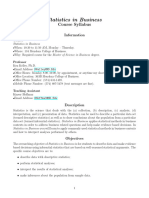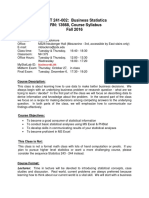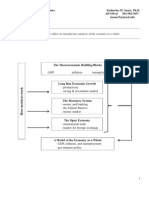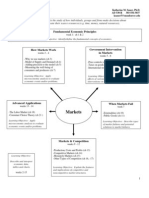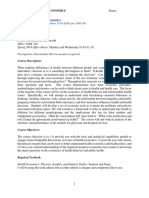0 ratings0% found this document useful (0 votes)
29 viewsECO206Syllabus 2022fall
This document outlines the preliminary syllabus for the course ECO206: Statistical Methods in Economics and Business II. The course covers topics in sampling distribution, hypothesis testing, and inference. It will be taught online in 5 sessions over the fall semester. Students will be evaluated based on weekly quizzes, homework assignments, and a take-home final exam. Academic honesty is strictly enforced.
Uploaded by
Matheus Hou ChenCopyright
© © All Rights Reserved
Available Formats
Download as PDF, TXT or read online on Scribd
0 ratings0% found this document useful (0 votes)
29 viewsECO206Syllabus 2022fall
This document outlines the preliminary syllabus for the course ECO206: Statistical Methods in Economics and Business II. The course covers topics in sampling distribution, hypothesis testing, and inference. It will be taught online in 5 sessions over the fall semester. Students will be evaluated based on weekly quizzes, homework assignments, and a take-home final exam. Academic honesty is strictly enforced.
Uploaded by
Matheus Hou ChenCopyright
© © All Rights Reserved
Available Formats
Download as PDF, TXT or read online on Scribd
You are on page 1/ 2
ECO206: Statistical Methods in Economics and Business II
Fall, 2022 (Preliminary Syllabus)
Sessions: Fall 2022
Lectures: N.A.
Classes: Online (Tencent meeting: 500 1755 6814) at 15:20-16:35 on Sep 30, Oct 14,
Oct 28, Nov 11, and Nov 25
Instructor: Qiang Feng, BoXue 1223, q.feng@uibe.edu.cn
Textbook: Statistics for Business and Economics, 13th ed. by David Anderson, Dennis
Sweeney, and Thomas Williams (or ASW for short). Published by Thomson
& South-Western. (It is available in China - ISBN: 978-7-111-35029-3)
Required Items: A (simple scientific) Calculator is a must!
Computational Software (Some proficiency in using Excel.)
Office Hours: Email and Wechat Q&A, or Tencent meetings may be arranged via email
or wechat.
Course Description and Objectives:
Statistics is a study of collecting and analyzing data for the purpose of making decisions
under conditions of uncertainty. It is especially critical in social sciences, such as in the study
of Economics and Business.
This course is the second of two Statistical Methods in Economics and Business classes. It is
designed to give you, the student, an appreciation and understanding of the use of descriptive
and inferential statistics in everyday life and research.
Topics covered are mainly in two areas: Sampling distribution and hypothesis testing. The
latter is further subdivided into testing about population mean or proportion, about the
difference between two population means or proportions, or about population variance, all of
which requires a firm understanding of the normal distribution.
Upon successful completion of this course, you should be able to analyze data sets, solve real
world statistical problems, and critically evaluate statistics used by others.
Course evaluation: A student’s achievement in this class will be gauged by weekly quizzes,
homework assignments, and one take-home final exam, with weights set as follow:
Final exam 20%
Quizzes 40%
Homework Assignments 40%
Make-up exams will only be given in the case of a well-documented (i.e., doctor's note)
emergency. Missed exams will be counted as zero. Please make sure to hand in your answer
on time. For late submissions, 10 points per 24 hours will be deducted from the exam
scores.
Weekly quizzes will be distributed and the deadline will be given on the question sheet.
Please pay extra attention to the date. Late submission will not be accepted.
Homework assignments are collected and recorded for the number of problems attempted,
but not graded for correctness. The deadline for submission will be given. Late submission
will not be accepted. You should check with the textbook at the end for those that do have
answers and see if you did them correctly. For those that don’t have answers, if you are
unsure about the solutions, you can ask me. These assignments are the minimum one needs to
do to understand the material; you are free to do more than the assigned work.
We will go through some of the homework questions in the online classes. You are
encouraged to attend the classes. However, I do understand that we may be in different time
zones and the class time may be inconvenient for you. Thus, attendance to classes is not
mandatory.
All submissions are through email. In the title of your email, you should label clearly (1) the
course number that is ECO206, (2) your name, (3) the type of submission (quiz, homework,
or exam) with the week it is for. Join the three parts with hyphens “-”. For example, when I
submit my answer to homework 4, the title of my email should be “ECO206-Qiang Feng-
Homework4”. Please note that I use a filter to move all submitted homework to a particular
folder in my email inbox. If you do not follow the pattern to name your submission emails, I
may not notice it. If I can’t find it easily, you don’t get credit.
In your email, please provide information of (1) the section & page the questions are from,
and (2) circle the problem numbers you attempted! You may either write your answer on
paper and take pictures (make sure the pictures are clear enough) or type your answer in a
Microsoft Word doc file. If you prefer to submit in other formats, please contact me
individually to make sure I can open your files.
Academic Honesty: I expect all students to follow the principles of academic honesty. If I
found anyone who cheated on any of the exams, regardless of who copied from whom, all of
them will automatically earn a failing grade! There will be no second chance. The same is
true for homework assignments. You can and should help each other on how to do the
homework assignments, but you have to do it by yourself.
I have high expectations of students. I honor hard work. I understand and sympathize with the
fact that some of you might have demanding jobs and have limited time for study. However,
without putting adequate time and effort into this class (at least 2 hours of study for each hour
of class), you probably will not get much out of it. If you need extra help, please seek help
early.
Course Outline
Questions Topics Ch.-Sect.
Are there Patterns in Life? Review of Normal Distribution 6
What Can a Sample Mean Tell Us? Sampling Distribution of the mean. 7.3-7.5
What Can a Sample % Tell Us? Sampling Distribution of the proportion. 7.6-7.8
Sample Mean + a Hat does What? Interval Estimation of the Pop. Mean μ. 8.1-8.2
Sample % + a Hat does What? Interval Estimation of the Pop. % 8.3-8.4
Can we proof anything? Intro. To Hypothesis Testing 9.1-3
Are claims about means true? Hypothesis Testing about Pop. Mean 9.4-5
Are claims about % true? Hypothesis Testing about Pop. % & Other Issues 9.6-9
Are 2 averages the same? Hypothesis Testing Between 2 Pop. Means 10.1-2
Hypothesis Testing Between 2 Pop. Means:
Any Change from before? 10.3
Matched Pairs
Are 2 percentages the same? Hypothesis Testing Between 2 Pop. Proportions 10.4
Getting ready for econometrics Review of Expectation, Var-Covariance 11
You might also like
- Parzen Stat104 Syllabus FALL 2017V6 Campus V4 PDFNo ratings yetParzen Stat104 Syllabus FALL 2017V6 Campus V4 PDF8 pages
- UT Dallas Syllabus For Epps6313.501.11s Taught by Timothy Bray (tmb021000)No ratings yetUT Dallas Syllabus For Epps6313.501.11s Taught by Timothy Bray (tmb021000)4 pages
- GOVT 702: Advanced Political Analysis Georgetown UniversityNo ratings yetGOVT 702: Advanced Political Analysis Georgetown University5 pages
- Econ 332 Economic Analysis of Labor Markets: Case Western Reserve UniversityNo ratings yetEcon 332 Economic Analysis of Labor Markets: Case Western Reserve University3 pages
- Stat W1211 Introduction To Statistics Sec 003 Spring 2012No ratings yetStat W1211 Introduction To Statistics Sec 003 Spring 20122 pages
- Accelerated Introduction To Statistical Methods (Syllabus)No ratings yetAccelerated Introduction To Statistical Methods (Syllabus)3 pages
- Mjxiao@stanford - Edu: Econ 51: Economic Analysis II Summer 2013No ratings yetMjxiao@stanford - Edu: Econ 51: Economic Analysis II Summer 20134 pages
- STAT 241 Syllabus (Fall 2016) Mark Blackmore Portland State University Business StatisticsNo ratings yetSTAT 241 Syllabus (Fall 2016) Mark Blackmore Portland State University Business Statistics6 pages
- Principles of Macroeconomics - SyllabusNo ratings yetPrinciples of Macroeconomics - Syllabus10 pages
- CSE549: Computational Biology: Professor Office Email My Office HoursNo ratings yetCSE549: Computational Biology: Professor Office Email My Office Hours3 pages
- UT Dallas Syllabus For Poec5313.5u1.09u Taught by Timothy Bray (tmb021000)No ratings yetUT Dallas Syllabus For Poec5313.5u1.09u Taught by Timothy Bray (tmb021000)6 pages
- UT Dallas Syllabus For Taught by Timothy Bray (tmb021000)No ratings yetUT Dallas Syllabus For Taught by Timothy Bray (tmb021000)4 pages
- MAT102 - Statistics For Business - UEH-ISB - T1 2021 - Unit Guide - SB1No ratings yetMAT102 - Statistics For Business - UEH-ISB - T1 2021 - Unit Guide - SB114 pages
- Honors Geometry Homework Answers For Section 1.4100% (1)Honors Geometry Homework Answers For Section 1.45 pages
- FE 610 Probability and Stochastic Processes For Finance: ObjectivesNo ratings yetFE 610 Probability and Stochastic Processes For Finance: Objectives5 pages
- Princeton Review PSAT/NMSQT Prep, 2025: 3 Practice Tests + Review + Online Tools for the Digital PSATFrom EverandPrinceton Review PSAT/NMSQT Prep, 2025: 3 Practice Tests + Review + Online Tools for the Digital PSATNo ratings yet
- Quantitative Methods or Quantitative Quiz 1 Prelim by Jezza100% (1)Quantitative Methods or Quantitative Quiz 1 Prelim by Jezza8 pages
- Dahal 2024 How Can Generative Ai Genai EnhanceNo ratings yetDahal 2024 How Can Generative Ai Genai Enhance15 pages
- Chapter 1 - The Nature of Probability and Statistics - Sections 1 and 2No ratings yetChapter 1 - The Nature of Probability and Statistics - Sections 1 and 234 pages
- DBU Thesis, Research, Research Proposal Guideline100% (1)DBU Thesis, Research, Research Proposal Guideline62 pages
- Imrad, Apa, Acm: Eunice B. Custodio, PH.DNo ratings yetImrad, Apa, Acm: Eunice B. Custodio, PH.D32 pages
- The Children's Busy Book Consists of Cooking, Game and ActivityNo ratings yetThe Children's Busy Book Consists of Cooking, Game and Activity2 pages
- What Is Research: RESEARCH - Is A Purposive, Systematic Process of Gathering, Analyzing, ClassifyingNo ratings yetWhat Is Research: RESEARCH - Is A Purposive, Systematic Process of Gathering, Analyzing, Classifying21 pages
- Assessment Brief - Global Challenges and Opportunities (3) (4) (2) (2) .Docx66459f3a1a7e863376No ratings yetAssessment Brief - Global Challenges and Opportunities (3) (4) (2) (2) .Docx66459f3a1a7e8633768 pages
- Research Manuscript Final Defense FormatNo ratings yetResearch Manuscript Final Defense Format7 pages
- Community Partisipation and Governemt RuralNo ratings yetCommunity Partisipation and Governemt Rural8 pages
- Laboratory Report Format and Grading RubricNo ratings yetLaboratory Report Format and Grading Rubric5 pages
- Lesson 4: Qualitative Approach in Language Research: West Visayas State University/2022No ratings yetLesson 4: Qualitative Approach in Language Research: West Visayas State University/20227 pages
- Analisis Faktor-Faktor Yang Mempengaruhi Produksi Industri Kecil Menengah Kerajinan Logam Di Kabupaten GianyarNo ratings yetAnalisis Faktor-Faktor Yang Mempengaruhi Produksi Industri Kecil Menengah Kerajinan Logam Di Kabupaten Gianyar14 pages




















